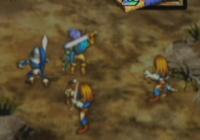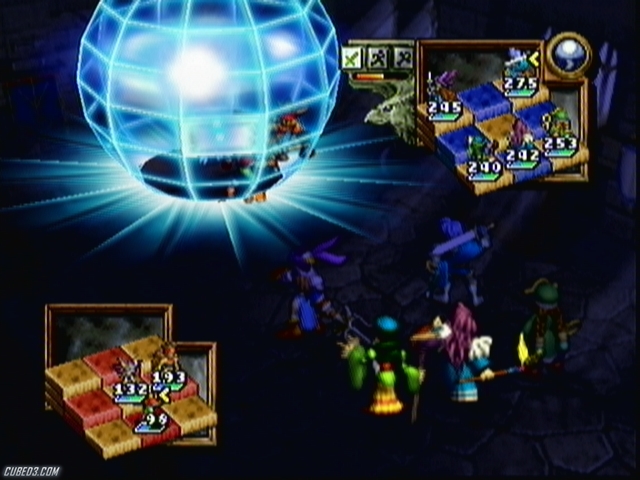Ogre Battle 64: Person of Lordly Caliber (Nintendo 64) Review

Towards the end of the Nintendo 64’s life, it seemed there was never going to be a proper RPG for the system. Then out of the blue came Ogre Battle 64: Person of Lordly Calibre, a sequel to the SNES games Ogre Battle: March of the Black Queen and Tactics Ogre: Let Us Cling Together, bringing hope to N64-owning Japanese and American RPG fans. Now thanks to the Hanabi Festival on Wii's Virtual Console, which facilitates the release of previously unavailable titles, people of PAL regions can play the game as well.
The game starts you off as Magnus Gallant, an 18 year old man with a particular affinity for the colour blue. He joins the Palatinus army and becomes head of the Southern division in a unit named by you, fighting initially against the Revolutionary Army, but after a full civil war breaks out and Magnus listens to his people, he decides to fight against the Palatinus army who have somehow summoned an old evil from the Holy Lodis Empire to fight with them. This is where the fun starts. Ogre Battle plays like a strategy RPG rather than your usual JRPGs such as Final Fantasy and Dragon Quest, aside the turn-based battles. You have two main priorities on every mission: the first is to defend your base from oncoming enemies, and the second is making sure that Magnus doesn’t die. Failing in either of these objectives will result in instant failure and the dreaded Game Over screen. The death of over units doesn’t have this effect, however.
The first thing you will come to is a a mission select screen, which gives you a menu with an array of options; select a mission or a city to enter, Organize Screen, Hugo Report, Area Investigation, Training, Settings and Save. You select missions on a map using a small arrow with the analogue stick to point to the area you want to go to next.

Once you select your mission you will go into a cut scene giving you a mission briefing by your tactician, Hugo, where he will generally tell you the best way to go about completing your mission. Once you’ve completed the briefing, the mission starts; you then select a unit and give them a command. This could be to move to the next city - usually to capture it - use an item to heal or revive a team mate in the unit, change the formation of the unit, set up camp if you’re outside a town or village, or go into a village. You start off with six different units, with a limit of five characters, but will have other characters join along the way as you trigger certain cutscenes, which allow you to create more units. When you’ve defeated the boss of a region and thus captured the enemy base, the mission is over and you take the territory for yourself, earning money and expendable soldiers.
Battles are presented like regular turn-based JRPG battles with the view being behind your team. Above the fight is a bar with three icons, Attack, Run and Elm Pedra, each powered by an Interrupt meter which fills up the more you survive. Once a character joins a battle they will fight automatically by themselves, though you do have choice over who they attack by pressing the R button on the Classic Controller. They could be commanded to swing for the leader of the enemy troops, have a go at the strongest foe, or pick off the weakest first - although some characters tend to attack whoever they can anyway. Battles usually don’t last long, because most characters only attack once or twice and the Run option fills up quite quickly on the Interrupt meter. Therefore most battles will end without anyone actually dying. When battles do end, you win, lose or draw; you win by doing the most damage to the enemy and vice versa with losing, and drawing sees you doing equal damage. Winning sends the enemy’s unit flying back through a path, and if you kill the whole of the enemy’s team, you collect an item. A loss will result in your own units being pushed back, or if you completely lose your team/unit leader, they will head back to base and disappear for the rest of the mission. Win or lose, unless all in your unit die, each character will gain at least one experience point, with more earned as the amount of enemies slain by your hand increases. These experience points, of course, allow you to level you up along the way, leading to more power in attack, defence and magic (if your character has it).
Another element in the battles is the Elm Pedra. These are mystical, elemental godly powers of the Holy Lodis Empire, with the first one being unlocked depending on your decision at the beginning of the game. There are six of these in total and you unlock more as you go along. You won't use them for the first 10 - 15 hours of the game as the battles don't last long enough for their icon on the Interrupt meter to fill at this point, but when you do get to use them they become a powerful asset to your army, doing multiple damages to the enemies.

Outside of the missions, if you select the 'Organize Screen' option, you can customise your units by switching characters around, give your units items to use during the missions, give them new weapons and armour bought from shops, and even change their classes, i.e. Knight, Soldier, Archer, Mage, etc.. Classes are split into male, female and non-human; choosing a non-human character like a dragon, however, takes up two spaces out of the five in your unit that you can use. There are several classes to choose from which decide on what types of weapons your character can use, how powerful their attacks are, how fast they attack, and if they can use magic or not. You can also create and disband units in the command units option. There is no limit to what class your character can be to lead the team, except that they can’t be expendable soldiers. If one or more of your characters die during a mission, you can revive them with an item you find during a mission. Alternately, you can go to an area you’ve already captured by selecting the 'Area Investigation' icon, and send the unit with the dead character to a witch's den to bring them back to life. These are, however, only in specific villages and can be hard to find, and they are also costly. The higher the level of your character, the more they will cost to revive. If, however, the leader of a unit dies, you will have to disband the unit and make them join another, since you cannot walk around with a dead leader. Exploring lands you’ve already captured can also bring other characters to your side, making you stronger, and you can find random items along the way, as well as going into a shop to buy items. Shops are usually in specific villages in each area, which you can peruse during missions.
Another mode on the mission select screen is Training mode which, for a certain amount of money, lets you battle to get your experience up. This will become a necessity after a few hours into the game, because the enemies you face become incredibly tough. These battles last until one of the teams is completely wiped out. If it is your team that dies, you will gain no experience points, and waste the money you spent on training. On the plus side, you won't have to revive anybody afterwards, and you can train until you run out of cash.
If you want to know more about your enemy, and the characters in the game, the Hugo Report Icon will let you know the history and current situation that each of the important characters you have come across, as well as important events you’ve played throughout the game, how long you’ve played it for, and some tips for knowing how to play the game. If you select people from the menu, you’ll see a tree of character photos that lets you know who’s on whose side.When you select a characters picture, Hugo will tell you all the current information about that character, and the information changes throughout the game.

There are certain decisions that Magnus (you) has to make during certain cutscenes, whether that’s letting a character join your army, or killing another character unmercifully outputs. Everything you do in these moments impacts upon the overall ending. There are six possible endings in total, one of which leads to an intriguing 'what if' moment at the end of the game...
On the visual side, the overworld doesn’t do too much, but it’s nice to see your units move around in a 3D battlefield,. You’ll see your character sprites walk over a plain green 3D world with some paths, mountains, rivers, and forests with small towns/castles to let you know where you’re going. The battle animations are nice, with the characters actually visually hitting each other. You can really tell the difference between 480i and 480p, too. As for the sounds, you get specific music for the missions, with the music varying during cutscenes or battles. Battle sounds are basic, with swords, bows, magic and elements being the main differences between the weapons, and battle cries depending on the gender, or type of monster your character may be, but they vary enough to know what’s going on.
Ogre Battle 64 is a very tough, sometimes frustrating, game, but out of the frustration often comes the enjoyment of winning, and completing the missions, giving the feeling that you’ve done well to outwit a computer-controlled army. Battles can take a long time and the frustration comes from units unnecessarily dying due to lack of power, your tactics, or being forced into a seemingly unlimited stream of battles without a pause to heal them. That’s not saying the game’s broken however; you always understand that it is your tactics that need refinement. The story is involving and since the choices you make will have an effect on the ending, there's a decent amount of replay factor to tempt you to play it over again. There is much fun to be had out of Ogre Battle, but don’t expect to enjoy it if you’re an impatient gamer who wants to get everything done ASAP.

Cubed3 Rating
Great - Silver Award

Ogre Battle is a very long, hard and interesting game. You can clock up over 100 hours if you really want to on a single campaign, and there are six different endings depending on decisions you make during the game, adding more reason to go back and try again. I thoroughly enjoyed it, although, I can see that it’s definitely not a game for everyone. This is one of the hardest, and most ‘hardcore’ games you’ll find on the VC; if you have the patience for it, it’s also one of the most rewarding.

![]() 8/10
8/10
![]() 8/10
(2 Votes)
8/10
(2 Votes)
 Out now
Out now  Out now
Out now  Out now
Out now  Out now
Out now Comments
Comments are currently disabled

 Sign In
Sign In 27.06.2010
27.06.2010  Game Details
Game Details Subscribe to this topic
Subscribe to this topic Features
Features





 Top
Top

